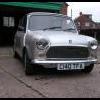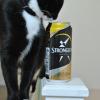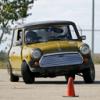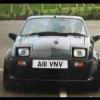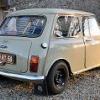Yes, and considering, for example, braking, the torque tries to rotate the subframe in the same direction as the wheels, i.e. front down, so download on the teardrops, and back up, so upload on the toeboard. The two rigid points at the tower mounts are in a straight line, and can't resist the torque, so the subframe will rock, because the rubbers will deflect. So all the torque and drag load is being reacted on the width (fore and aft) of the subframe to bulkhead crossmember spacer, which is about 1.5 inches if I remember correctly. The crossmember is sheet metal.....
But it gets worse, much worse, if suspension loads due to bump and cornering are added in.
All rubber mounts, and the entire subframe moves about (which is why we don't like rubber mounts here!), and if the stiffness of the rubbers is roughly similar, the loads will be spread reasonably well over all 6 mounts.
All solid, as Issigonis originally designed it, and the shell and subframe mutually stiffen each other, which is very good.
The problem with fitting solid mounts and not reinforcing the toeboard is because the original design had one bolt at each side vertically through the floor, and the other at an angle through the toeboard, so the subframe end was clamped to the corner of floor and bulkhead, which is stiff. The newer, rubber mounted design has shorter subframe rear extensions and the solid mount just substitutes steel for the rubber, putting the load into the flat metal of the toeboard. Because the front end is not all that stiff, due to the tower cut outs in the inner wings and the wheel arches in the outer wings, the front mounts in themselves will not stop the subframe rocking fore and aft, so the toeboard mounts, in the middle of a flat sheet, will make it deflect, and eventually crack, which is why a reinforcing plate is added around each mount.
So, all solid with toeboard reinforcing is best (or an early solid mounted car), and all rubber is second best.
We don't mix rubber and poly because not only are the poly teardrop and toeboard mounts currently on the market complete structural abominations, which will stretch, but they have very different stiffness than the rubber mounts, so the stresses will spread very unequally, and something will suffer.
And don't get me going on flip fronts, with the teardrop mounts no longer carrying loads, and the bracing bars, usually ineptly designed, carrying subframe fore and aft torque loading only a very short distance above the tower mount seatings, so there is an enormous bending load induced..... Not that the obsessive front end chopper-offers will understand any of this or believe what I say, of course.
Issigonis introduced the subframes after many thousands of miles of thrashing the "orange box" prototypes around Oxfordshire, because the previous structure tended to crack, and many billions of miles of Mini use on the road has proved that he got it right, because fatigue cracking around the mounts was completely unknown, except in very severe conditions such as rallying on very poor surfaces, which break any car eventually. The wimpy rubber mounts were designed by some relatively junior engineer, and in my opinion had insufficient testing, as I have seen toeboard mounts break after about 10k or road use. Sometimes, the original is best, and that is one of these occasions. A proper solid mount kit, with reinforced toeboard, is basically as good as the original.


